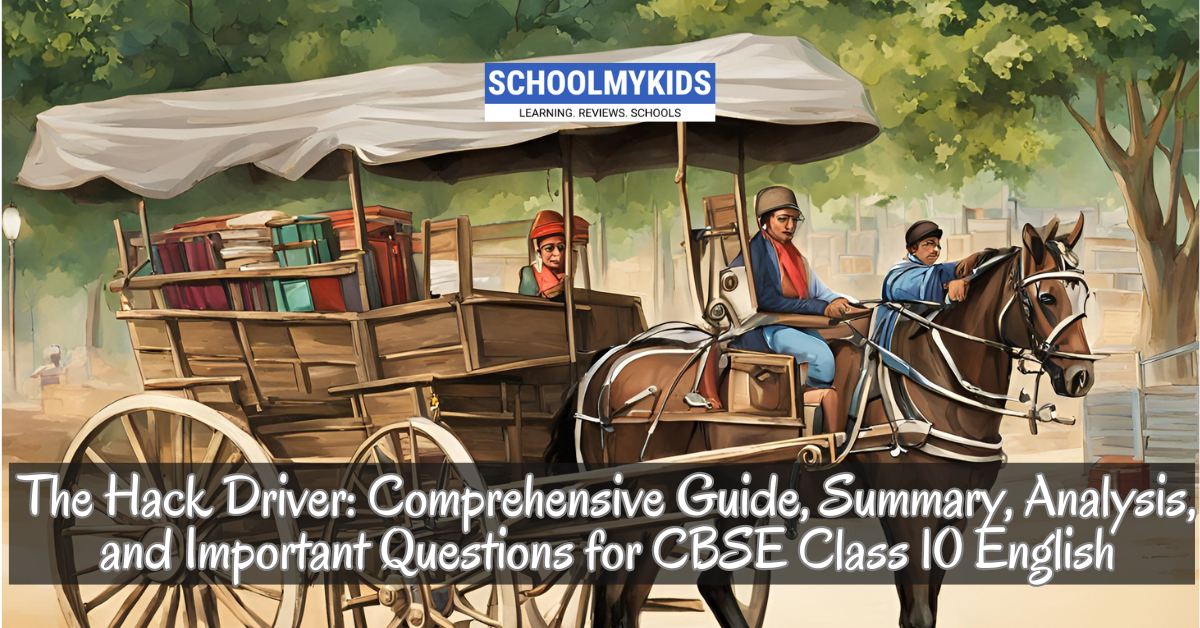Summary
“The Hack Driver” is an engaging short story by Sinclair Lewis, included in the CBSE Class 10 English curriculum. The story revolves around a young and inexperienced lawyer who is tasked with serving a summons to a man named Oliver Lutkins. The lawyer narrates his experiences as he travels to a small village called New Mullion, where he encounters a friendly and seemingly helpful hack driver named Bill.
Upon arriving in New Mullion, the young lawyer, keen to find Lutkins, enlists the help of Bill, who offers to drive him around the village to locate the elusive man. Throughout the day, Bill takes the lawyer on a wild goose chase, visiting various locations such as Fritz’s shop, Gray’s barbershop, and the pool room, claiming that Lutkins was just there or might be at the next stop.
As the day progresses, Bill regales the lawyer with amusing anecdotes and insights into the lives of the villagers. The lawyer, despite growing suspicious of Lutkins’ constant absence, enjoys Bill’s company and begins to trust him. It is only later that the lawyer discovers the truth: Bill is, in fact, Oliver Lutkins, who has been cleverly deceiving him all along to avoid being served the summons.
Analysis
“The Hack Driver” explores themes of deception, naivety, and the gap between appearance and reality. The story highlights how easily one can be misled by appearances and how trust can be misplaced. The young lawyer’s naivety and eagerness to complete his task make him an easy target for Lutkins’ clever ruse.
Sinclair Lewis uses humor and irony to enhance the narrative, creating a story that is both entertaining and thought-provoking. The character of Bill, or Lutkins, is portrayed as charming and resourceful, using his wit to outsmart the lawyer. The lawyer’s transformation from a confident professional to a befuddled and embarrassed novice adds a layer of humor and irony to the story.
The story also reflects on the human tendency to trust those who appear friendly and helpful, often overlooking potential deceit. The lawyer’s experience serves as a cautionary tale about the importance of critical thinking and skepticism, especially when dealing with unfamiliar situations and individuals.
Important Questions with Explanations
- What is the central theme of “The Hack Driver”?
- The central theme is deception and the gap between appearance and reality. The story highlights how easily one can be misled by appearances and trust misplaced.
- Describe the young lawyer’s character.
- The young lawyer is inexperienced, eager, and somewhat naive. His inexperience makes him an easy target for Lutkins’ deception.
- How does Bill deceive the young lawyer?
- Bill, who is actually Oliver Lutkins, pretends to be a helpful hack driver and takes the lawyer on a wild goose chase around the village to avoid being served the summons.
- What is the significance of the story’s title, “The Hack Driver”?
- The title refers to Bill, the hack driver, who plays a central role in the story by deceiving the young lawyer and leading him on a futile search.
- How does humor play a role in the story?
- Humor is used to highlight the lawyer’s naivety and the absurdity of the situation. The witty dialogues and the lawyer’s gullible nature add a comedic element to the narrative.
- What lesson does the young lawyer learn by the end of the story?
- The lawyer learns the importance of skepticism and critical thinking. He realizes that appearances can be deceiving and that trust must be earned, not given freely.
- How does Sinclair Lewis create suspense in the story?
- Suspense is created through the lawyer’s fruitless search for Lutkins, the various encounters with villagers, and the eventual revelation of Bill’s true identity.
- What role does the setting of New Mullion play in the story?
- The rural setting of New Mullion adds to the charm and deception. The seemingly simple and straightforward village contrasts with the cunning and deceitful behavior of Lutkins.
- Analyze the character of Oliver Lutkins.
- Oliver Lutkins is resourceful, charming, and clever. He uses his wit to deceive the lawyer and avoid being served the summons, showcasing his ability to manipulate situations to his advantage.
- Discuss the theme of trust in “The Hack Driver”.
- Trust is a central theme, as the lawyer’s misplaced trust in Bill leads to his deception. The story underscores the need to critically evaluate situations and people before placing trust in them.
- How does the lawyer’s perspective change throughout the story?
- The lawyer starts off confident and eager but becomes increasingly frustrated and suspicious as the day progresses. By the end, he feels embarrassed and wiser for the experience.
- What is the impact of the story’s twist ending on the reader?
- The twist ending surprises the reader and reinforces the story’s themes of deception and the gap between appearance and reality. It leaves a lasting impression about the importance of skepticism.
- How does Sinclair Lewis use irony in the story?
- Irony is present in the lawyer’s confidence and professional demeanor being undermined by Lutkins’ deception. The contrast between the lawyer’s expectations and the reality he faces adds to the story’s humor and depth.
- What does the story suggest about human nature and gullibility?
- The story suggests that people can be easily deceived when they are too trusting or fail to question appearances. It highlights the human tendency to take things at face value.
- How does the story explore the concept of professional inexperience?
- The young lawyer’s inexperience is evident in his inability to see through Lutkins’ ruse. The story explores how inexperience can lead to gullibility and mistakes in judgment.
- What is the significance of the various locations visited in the story?
- The locations visited, such as Fritz’s shop and Gray’s barbershop, serve to prolong the deception and create a sense of a wild goose chase, adding to the story’s suspense and humor.
- Analyze the narrative style of Sinclair Lewis in “The Hack Driver”.
- Lewis’ narrative style is straightforward and engaging, using humor and irony to effectively convey the story’s themes and keep the reader entertained.
- What role do the villagers play in the story?
- The villagers, who seem unaware of the lawyer’s true purpose, contribute to the authenticity of Bill’s deception. They add to the lawyer’s sense of being led on a genuine search.
- How does the story address the theme of appearance versus reality?
- The story highlights the discrepancy between appearance and reality through Lutkins’ disguise as Bill and the lawyer’s gullible acceptance of his help, only to realize the truth later.
- What overall message does “The Hack Driver” convey?
- The story conveys that appearances can be deceiving and that it is essential to approach situations and people with a critical mind. It underscores the importance of experience and skepticism in professional and personal interactions.
Conclusion
“The Hack Driver” by Sinclair Lewis is a humorous and insightful story that explores themes of deception, naivety, and the gap between appearance and reality. Through the experiences of the young lawyer, the story highlights the importance of critical thinking and skepticism in navigating unfamiliar situations and individuals. For students preparing for the CBSE Class 10 English exam, understanding this story provides valuable insights into character development, thematic exploration, and narrative techniques, enriching their literary knowledge and analytical skills.








Be the first one to comment on this story.